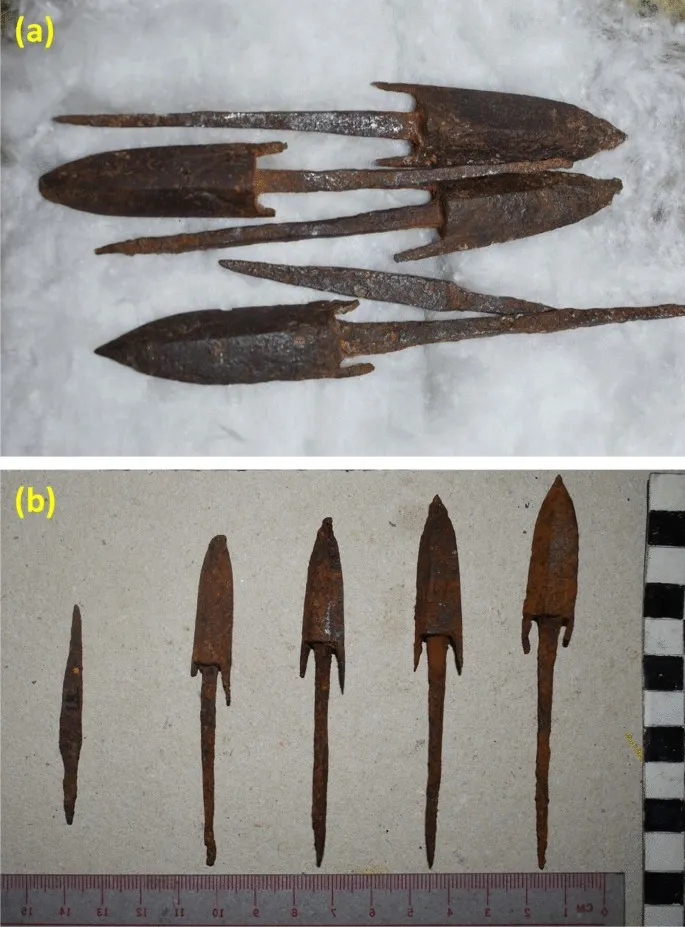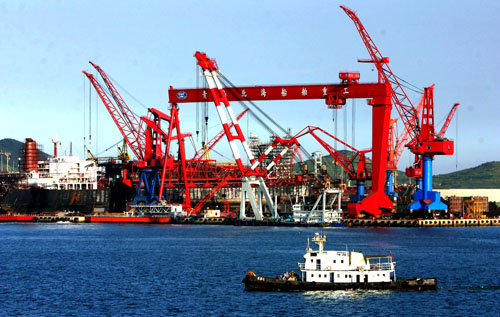1. Frank, H. Good year, archaeological site science. pp 131–132 (1988).
2. Yang Sook, K. & Istvan, S. Cleaning of corroded iron artifacts using pulsed TEA CO2 and Nd: YAG lasers. J. Cult. Herit. 4, 129–133 (2003).
3. Hefter, G., North, A. & Tan, S. Organic corrosion inhibitors in neutral solutions; part-I Inhibition of steel, copper, and aluminum by straight chain carboxylates. Corrosion 53(8), 657–667. https://doi.org/10.5006/1.3290298 (1997).
4. Alkharafi, F. M., El-Shamy, A. M. & Ateya, B. G. Comparative effect of tolytriazole and benzotriazole against sulfide attack on copper. Int. J. Electrochem. Sci. 4, 1351–1364 (2009).
5. Mirambet, F., Reguer, S., Rocca, E., Hollner, S. & Testemale, D. A. Complementary set of electrochemical and X-ray synchrotron techniques to determine the passivation mechanism of iron treated in a new corrosion inhibitor solution specifically developed
for the preservation of metallic artifacts. Appl. Phys. A 99, 341–349 (2010).
6. Sherif, E. M., Abbas, A. T., Gopi, D. & El-Shamy, A. M. Corrosion and corrosion inhibition of high strength low alloy steel in 2.0 M sulfuric acid solutions by 3-amino-1,2,3-triazole as a corrosion inhibitor. J. Chem. https://doi.org/10.1155/2014/538794 (2014).
7. Bethencourt, M., Botana, F. J., Calvino, J. J., Marcos, M. & Rodriguez-Chacon, M. A. Lanthanide compounds as environmentally friendly corrosion inhibitors of aluminum alloys: A review. Corros. Sci. 40(11), 1803–1819. 00077-8 (1998).
8. Sabirneeza, A. A. F., Geethanjali, R. & Subhashini, S. Polymeric corrosion inhibitors for iron and its alloys: A review. Chem. Eng. Commun. 202(22), 232–244. https://doi.org/10.1080/00986445.2014.934448 (2015).
9. Sherif, E. M., Abbas, A. T., Halfa, H. & El-Shamy, A. M. Corrosion of high strength steel in concentrated sulfuric acid pickling solutions and its inhibition by 3-amino-5-mercapto-1, 2, 3-triazole. Int. J. Electrochem. Sci 10, 1777–1791 (2015).
10. Dillmann, P., Beranger, G., Piccardo, P. & Matthiessen, H. Corrosion of Metallic Heritage Artefacts: Investigation, Conservation, and Prediction of Long-Term Behavior (Elsevier, 2014).
11. El-Shamy, A. M., Shehata, M. F. & Ismail, A. I. M. Effect of moisture contents of bentonitic clay on the corrosion behavior of steel pipelines. J. Appl. Clay Sci. 114, 461–466. https://doi.org/10.1016/j.clay.2015.06.041 (2015).
12. Singh, P., Srivastava, V. & Quraishi, M. A. Novel quinoline derivatives as green corrosion inhibitors for mild steel in acidic medium: electrochemical, SEM, AFM, and XPS studies. J. Mol. Liquids 216(1), 164–173. https://doi.org/10.1016/j.molliq.2015.12.086 (2016).
13. Farag, H. K., El-Shamy, A. M., Sherif, E. M. & El Abedin, S. Z. Sonochemical Synthesis of Nanostructured ZnO/Ag Composites in an Ionic Liquid. Zeitschrift für Physikalische Chemie 230(12), 1733–1744. https://doi.org/10.1515/zpch-2016-0777 (2016).
14. Elsayed, E. M., Eessaa, A. K., Rashad, M. M. & El-Shamy, A. M. Preparation and characterization of ZnO thin film on anodic Al2O3as a substrate for several applications. Egypt. J. Chem. 65(10), 119–129. https://doi.org/10.21608/ejchem.2022.110382.5021 (2022).
15. El-Shamy, A. M., Farag, H. K. & Saad, W. M. Comparative study of removal of heavy metals from industrial wastewater using clay and activated carbon in batch and continuous flow systems. Egypt. J. Chem. 60(6), 1165–1175. https://doi.org/10.21608/ejchem.2017.1606.1128 (2017).
16. Liu, A. M., Ren, X. F., Wang, B., Zhang, J., Yang, P. X., Zhang, J. Q., An, M. Z. Complexing agent study via computational chemistry for environmentally friendly silver (2014).
17. El-Shamy, A. M., Shehata, M. F., Metwally, H. I. M. & Melegy, A. Corrosion and corrosion inhibition of steel pipelines in montmorilonitic soil filling material. Silicon 10(6), 2809–2815. https://doi.org/10.1007/s12633-018-9821-4 (2017).
18. Sanatkumar, B., Nayak, J. & Shetty, N. Influence of 2-(4-chlorophenyl)-2-oxoethyl benzoate on the hydrogen evolution and corrosion inhibition of 18 Ni 250 grade weld aged maraging steel in 1.0 M sulfuric acid medium. Int. J. Hydrog. Energy 37(11), 9431–9442. https://doi.org/10.1016/j.ijhydene.2012.02.165 (2012).
19. Giumlia, M. A., Williams, A. Studi metallografici ‘in situ’ sull’armatura della Basilica della Beata Vergine delle Grazie, Udine, Aquileia Nostra, LXXV Udine, Aquileia, 394–422 (2004).
20. El-Shamy, A. M. Control of corrosion caused by sulfate-reducing bacteria. In Microbes in process, pp. 337–362 (2014).
21. Scharff, W. & Huesmann, I. A. Accelerated decay of metal soil finds due to soil pollution. Metal 95, 17–20 (1997).
22. Ateya, B. G., Al Kharafi, F. M., El-Shamy, A. M., Abdalla, R. M. Electrochemical oxidation of hydrogen sulfide in geothermal fluids under high temperature and pressure. In ACS National Meeting Book of Abstracts 2008 236th National Meeting and Exposition of the American Chemical Society, ACS 200817 August 2008 through 21 August (2008).
23. Ateya, B. G., Alkharafi, F. M., El-Shamy, A. M., Saad, A. Y. & Abdalla, R. M. Electrochemical desulphurization of geothermal fluids under high temperature and pressure. J. Appl. Electrochem. 39, 383–389. https://doi.org/10.1007/s10800-008-9683-3 (2009).
24. Abdelshafeek, K. A., Abdallah, W. E., Elsayed, W. M., Eladawy, H. A. & El-Shamy, A. M. Vicia faba peel extracts bearing fatty acids moieties as a cost-effective and green corrosion inhibitor for mild steel in marine water: Computational and electrochemical
studies. Sci. Rep. 12(1), 20611. https://doi.org/10.1038/s41598-022-24793-3 (2022).
25. Abd Elkarim, A. M., El-Shamy, A. M., Megahed, M. M. & Kalmouch, A. Evaluation of the inhibition efficiency of a new inhibitor on leaded bronze Statues from Yemen. Arctic J. 71(1), 2–33 (2018).
26. Cano, E. et al. Electrochemical characterization of organic coatings for protection of historic steel artifacts. J. Solid State Electr. 14, 453 (2010).
27. Eessaa, A. K., El-Shamy, A. M. & Reda, Y. Fabrication of commercial nanoporous alumina by low voltage anodizing. Egypt. J. Chem.61(1), 175–185. https://doi.org/10.21608/ejchem.2017.2189.1175 (2018).
28. Satri, V. Green Corrosion Inhibitors: Theory and Practice (Wiley, 2011).
29. El-Shamy, A. M., Abdelfattah, I., Elshafie, O. I. & Shehata, M. F. Potential removal of organic loads from petroleum wastewater and its effect on the corrosion behavior of municipal networks. J. Environ. Manag. 219, 325–331. https://doi.org/10.1016/j.jenvm
an.2018.04.074 (2018).
30. Elban, W. L., Borst, M. A., Roubachewsky, N. M., Kemp, E. L. & Tice, P. C. Metallurgical assessment of historic wrought iron: US custom house, wheeling, West Virginia. Assoc. Preserv. Technol. 29, 27–34 (1998).
31. Bramfitt, B. L., Benscoter, A.O. Metallographer’s guide: Practices and procedures for irons and steels, USA (2002).
32. Bussell, M. Use of iron and steel in buildings. In Structures & Construction in Historic Building Conservation (ed. Forsyth, M.) 173–191 (Blackwell Publishing Ltd, 2007).
33. Reda, Y., El-Shamy, A. M. & Eessaa, A. K. Effect of hydrogen embrittlement on the microstructures of electroplated steel alloy 4130. Ain Shams Eng. J. 9(4), 2973–2982. https://doi.org/10.1016/j.asej.2018.08.004 (2018).
34. Al-Otaibi, M. S. et al. Corrosion inhibitory action of some plant extracts on the corrosion of mild steel in acidic media. Arab. J. Chem. 7, 340–346 (2014).
35. El-Kashef, E., El-Shamy, A. M., Abdo, A., Gad, E. A. M. & Gado, A. A. Effect of magnetic treatment of potable water in looped and dead-end water networks. Egypt. J. Chem. 62(8), 1467–1481. https://doi.org/10.21608/ejchem.2019.7268.1595 (2019).
36. Zajec, B., Leban, M. B., Lenart, S., Gavin, K. & Legat, A. Electrochemical impedance and electrical resistance sensors for the evaluation of anticorrosive coating degradation. Corros. Rev. 35, 65–74 (2017).
37. Abbas, M. A., Zakaria, K., El-Shamy, A. M. & El Abedin, S. Z. Utilization of 1-butylpyrrolidinium chloride ionic liquid as an ecofriendly corrosion inhibitor and biocide for oilfield equipment: combined weight loss, electrochemical and SEM studies Z. Phys. Chem. 235(4), 377–406. https://doi.org/10.1515/zpch-2019-1517 (2019).
38. Xia, D. H. et al. Assessing atmospheric corrosion of metals by a novel electrochemical sensor combining with a thin insulating net using electrochemical noise technique. Sens. Actuat. B Chem. 252, 353–358 (2017).
39. Shehata, M. F., El-Shafey, S., Ammar, N. A. & El-Shamy, A. M. Reduction of Cu+2 and Ni+2 ions from wastewater using mesoporous adsorbent: Effect of treated wastewater on corrosion behavior of steel pipelines. Egypt. J. Chem. 62(9), 1587–1602. https://doi.org/10.21608/ejchem.2019.7967.1627 (2019).
40. Scott, D. A. & Eggert, G. Iron and Steel in Art: Corrosion, Colorants, Conservation 145–147 (Archetype Publications, 2009).
41. El-Shamy, A. M., Soror, T. Y., El-Dahan, H. A., Ghazy, E. A. & Eweas, A. F. Microbial corrosion inhibition of mild steel in salty water environment. Mater. Chem. Phys. 114(1), 156–159. https://doi.org/10.1016/j.matchemphys.2008.09.003 (2009).
42. Zohdy, K. M., El-Shamy, A. M., Gad, E. A. M. & Kalmouch, A. The corrosion inhibition of (2Z,2′Z)-4,4′-(1,2-phenylene bis (azanediyl)) bis (4-oxobut-2-enoic acid) for carbon steel in acidic media using DFT. Egypt. J. Pet. 28(4), 355–359. https://doi.org/10.1016/j.ejpe.2019.07.001 (2019).
43. Ma, C. et al. Electrochemical noise monitoring of the atmospheric corrosion of steels: Identifying corrosion form using wavelet analysis. Corros. Eng. Sci. Technol. 52, 432–440 (2017).
44. Reda, Y., El-Shamy, A. M., Zohdy, K. M. & Eessaa, A. K. Instrument of chloride ions on the pitting corrosion of electroplated steel alloy 4130. Ain Shams Eng. J. 11, 191–199. https://doi.org/10.1016/j.asej.2019.09.002 (2020).
45. Cano, E., Lafuente, D. Corrosion inhibitors for the preservation of metallic heritage artifacts. In Corrosion and conservation of cultural heritage metallic artefacts; Elsevier: New York, NY, USA, 570–594 (2013).
46. Reda, Y., Zohdy, K. M., Eessaa, A. K. & El-Shamy, A. M. Effect of plating materials on the corrosion properties of steel alloy 4130. Egypt. J. Chem. 63(2), 579–597. https://doi.org/10.21608/ejchem.2019.11023.1706 (2020).
47. Mohamed, W. A. & Mohamed, N. M. Testing coatings for enameled metal artifacts. Int. J. Conserv. Sci. 8, 15–24 (2017).
48. Mohamed, O. A., Farghali, A. A., Eessaa, A. K. & El-Shamy, A. M. Cost-effective and green additives of pozzolanic material derived from the waste of alum sludge for successful replacement of Portland cement. Sci. Rep. 12(1), 20974. https://doi.org/10.1038/s41598-022-25246-7 (2022).
49. Shehata, M. F., El-Shamy, A. M., Zohdy, K. M., Sherif, E. S. M. & El Abedin, S. Z. Studies on the antibacterial influence of two ionic liquids and their corrosion inhibition performance. Appl. Sci. 10(4), 1444. https://doi.org/10.3390/app10041444 (2020).
50. El-Shamy, A. M., El-Hadek, M. A., Nassef, A. E. & El-Bindary, R. A. Optimization of the influencing variables on the corrosion property of steel alloy 4130 in 3.5 wt.% NaCl solution. J. Chem. https://doi.org/10.1155/2020/9212491 (2020).
51. Rodgers, B. A. The Archaeologist’s Manual for Conservation 186–200 (Kluwer Academic/Plenum Publishers, 2004).
52. Devanathan, M. A. V. & Tilak, B. V. K. The structure of the electrical double layer at the metal–solution interface. Chem. Rev. 65, 635–684 (1965).
53. Parsons, R. Electrical double layer: Recent experimental and theoretical developments. Chem. Rev. 90, 813–826 (1990).
54. Kolb, D. M., Rath, D. L., Wille, R. & Hansen, W. N. An ESCA study on the electrochemical double layer of emersed electrodes.
Ber. Bunsenges. Phys. Chem. 87, 1108–1113 (1983).
55. Brown, M. A. et al. Determination of surface potential and electrical double-layer structure at the aqueous electrolyte–nanoparticle interface. Phys. Rev. X 6, 011007 (2016).
56. El-Shamy, A. M., El-Hadek, M. A., Nassef, A. E. & El-Bindary, R. A. Box-Behnken design to enhance the corrosion resistance of high strength steel alloy in 3.5 wt% NaCl solution. Mor. J. Chem. 8(4), 788–800. https://doi.org/10.48317/IMIST.PRSM/morjc
hem-v8i4.21594 (2020).
57. Mills, D., Picton, P. & Mularczyk, L. Developments in the electrochemical noise method (ENM) to make it more practical for assessment of anti-corrosive coatings. Electrochim. Acta 124, 199–205 (2014).
58. El-Shamy, A. M. A review on biocidal activity of some chemical structures and their role in mitigation of microbial corrosion. Egypt. J. Chem. 63(12), 5251–5267. https://doi.org/10.21608/ejchem.2020.32160.2683 (2020).
59. ASTM b499–09, Standard Test Method for Measurement of Coating Thicknesses by the Magnetic Method: Nonmagnetic Coatings on Magnetic Basis Metals; ASTM International: West Conshohocken, PA, USA (2014).
60. Megahed, M. M., Youssif, M. & El-Shamy, A. M. Selective formula as a corrosion inhibitor to protect the surfaces of antiquities made of leather-composite brass alloy. Egypt. J. Chem. 63(12), 5269–5287. https://doi.org/10.21608/ejchem.2020.41575.2841 (2020).
61. ASTM e104–02, Standard Practice for Maintaining Constant Relative Humidity by Means of Aqueous Solutions; ASTM International: West Conshohocken, PA, USA (2012).
62. Megahed, M. M., Abdel Bar, M. M., Abouelez, E. S. M. & El-Shamy, A. M. Polyamide coating as a potential protective layer against corrosion of iron artifacts. Egypt. J. Chem. 64(10), 5693–5702. https://doi.org/10.21608/ejchem.2021.70550.3555 (2021).
63. Mabbutt, S., Mills, D. J. & Woodcock, C. P. Developments of the electrochemical noise method (ENM) for more practical assessment of anti-corrosion coatings. Prog. Org. Coat. 59, 192–196 (2007).
64. Zohdy, K. M., El-Sherif, R. M. & El-Shamy, A. M. Corrosion and passivation behaviors of tin in aqueous solutions of different pH. J. Bio Tribo-Corros. 7(2), 1–7. https://doi.org/10.1007/s40735-021-00515-6 (2021).
65. Pham, T. D. From fuzzy recurrence plots to scalable recurrence networks of time series. EPL-Europhys. Lett. 118, 20003 (2017).
66. El-Shamy, A. M. & Abdel Bar, M. M. Ionic liquid as water soluble and potential inhibitor for corrosion and microbial corrosion for iron artifacts. Egypt. J. Chem. 64(4), 1867–1876. https://doi.org/10.21608/ejchem.2021.43786.2887 (2021).
67. Cazares-Ibanez, E., Vazquez-Coutino, G. A. & Garcia-Ochoa, E. Application of recurrence plots as a new tool in the analysis of electrochemical oscillations of copper. J. Electroanal. Chem. 583, 17–33 (2005).
68. Zohdy, K. M., El-Sherif, R. M., Ramkumar, S. & El-Shamy, A. M. Quantum and electrochemical studies of the hydrogen evolution findings in corrosion reactions of mild steel in acidic medium. Upstream Oil Gas Technol. 6, 100025. https://doi.org/10.1016/j.upstre.2020.100025 (2021).
69. Wadsworth, F. B., Heap, J. M. & Dingwell, D. B. Friendly fire: Engineering a fort wall in the iron age. J. Archaeol. Sci. 67, 7–13 (2016).
70. Gad, E. A. & El-Shamy, A. M. Mechanism of corrosion and microbial corrosion of 1,3-dibutyl thiourea using the quantum chemical calculations. J. Bio Tribo-Corros. 8, 71. https://doi.org/10.1007/s40735-022-00669-x (2022).
71. Oudbashi, O., Emami, S. M., Ahmadi, H. & Davami, P. Micro-stratigraphical investigation on corrosion layers in ancient bronze artefacts by scanning electron microscopy energy dispersive spectrometry and optical microscopy. Herit. Sci. 1, 21–31 (2013).
72. Abbas, M. A., Ismail, A. S., Zakaria, K., El-Shamy, A. M. & El Abedin, S. Z. Adsorption, thermodynamic, and quantum chemical investigations of an ionic liquid that inhibits corrosion of carbon steel in chloride solutions. Sci. Rep. 12, 12536. https://doi.org/10.1038/s41598-022-16755-6 (2022).
73. Abdel-Karim, A. M., El-Shamy, A. M. & Reda, Y. Corrosion and stress corrosion resistance of Al Zn alloy 7075 by nano-polymeric coatings. J. Bio- Tribo-Corros. 8, 57. https://doi.org/10.1007/s40735-022-00656-2 (2022).
74. El-Shamy, A. M., Cathodic protection in the oil and gas industries. In Corrosion and Materials in the oil and gas industry, pp. 489–510 (2016).
75. Jegdic, B., Radovanavic, S. P., Ristic, S. & Alil, A. Corrosion Processes nature and composition of corrosion products on iron artefacts of weaponry. Sci. Tech. Rev. 61(2), 50–56 (2011).
76. Abdel-Karim, A. M. & El-Shamy, A. M. A review on green corrosion inhibitors for protection of archeological metal artifacts. J. Bio- Tribo-Corros. 8, 35. https://doi.org/10.1007/s40735-022-00636-6 (2022).
77. Webber, C. L. Jr. Recurrence Quantification Analysis: Theory and Best Practices (Springer, 2014).
78. Landolt, D. Corrosion and Surface Chemistry of Metals, Lausanne, Switzerland (ISBN 978-2-940222-11-7), 119–179 (2007).
79. Mouneir, S. M., El-Hagrassi, A. M. & El-Shamy, A. M. A review on the chemical compositions of natural products and their role in setting current trends and future goals Egypt. J. Chem. 65(5), 491–506. https://doi.org/10.21608/ejchem.2021.95577.4486 (2022).
80. Loeper-Attia, M. A. A Proposal to Describe Reactivated Corrosion of Archaeological Iron Objects. In Corrosion of Metallic Heritage Artefacts: Investigation, Conservation, and Prediction For Long-Term Behavior (eds Dillmann, P. et al.) 190–202 (Woodhead Publishing, 2007).
81. Reda, Y., Yehia, H. M. & El-Shamy, A. M. Microstructural and mechanical properties of Al-Zn alloy 7075 during RRA and triple aging. Egypt. J. Pet. 31, 9–13. https://doi.org/10.1016/j.ejpe.2021.12.001 (2022).
82. Branzoi, F., Branzoi, V. & Licu, C. Corrosion inhibition of carbon steel in cooling water systems by new organic polymers as green inhibitors. Mater. Corros. Werkstoffe Korrosion 65(6), 637–647. https://doi.org/10.1002/maco.201206579 (2014).
83. Elsayed, E. M., Eessaa, A. K., Abdelbasir, S. M., Rashad, M. M. & El-Shamy, A. M. El-Fabrication, characterization, and monitoring the propagation of nanocrystalline ZnO thin film on ITO substrate using electrodeposition technique. Egypt. J. Chem. 66(2), 33–43. https://doi.org/10.21608/ejchem.2022.126134.5595 (2023).
84. El-Shamy, A. M. & Mouneir, S. M. Medicinal materials as eco-friendly corrosion inhibitors for industrial applications: A review. J. Bio Tribo-Corrosion 9(1), 3. https://doi.org/10.1007/s40735-022-00714-9 (2023).
85. Zohdy, K. M., El-Sherif, R. M. & El-Shamy, A. M. Effect of pH fluctuations on the biodegradability of nanocomposite mg-alloy in simulated bodily fluids. Chem. Paper 77(3), 1317–1337. https://doi.org/10.1007/s11696-022-02544-y (2023).
86. Alwaleed, R. A., Megahed, M. M., Elamary, R. B., El-Shamy, A. M. & Ali, Y. S. Remediation mechanism of microbial corrosion for iron artifacts buried in soil by using allium sativum (garlic extract) as a natural biocide. Egypt. J. Chem. 66(6), 291–308. https://doi.org/10.21608/ejchem.2022.158454.6850 (2023).
87. Eessaa, A. K. & El-Shamy, A. M. Review on fabrication, characterization, and applications of porous anodic aluminum oxide films with tunable pore sizes for emerging technologies. Microelectr. Eng. 279, 112061. https://doi.org/10.1016/j.mee.2023.112061 (2023).
88. Eessaa, A. K., Elkady, O. A. & El-Shamy, A. M. Powder metallurgy as a perfect technique for preparation of Cu-TiO2 composite by identifying their microstructure and optical properties. Sci. Rep. 13(1), 7034. https://doi.org/10.1038/s41598-023-33999-y (2023).
89. Ghazy, E. A., Abdel Ghany, N. A. & El-Shamy, A. M. Comparative study of cetyl trimethyl ammonium bromide formaldehyde, and isobutanol against corrosion and microbial corrosion of mild steel in chloride media. J. Bio. Tribo-Corrosion 9, 64. https://doi.org/10.1007/s40735-023-00782-5 (2023).
90. Abdelshafeek, K. A. & El-Shamy, A. M. Review on glucosinolates: Unveiling their potential applications as drug discovery leads in extraction, isolation, biosynthesis, biological activity, and corrosion protection. Food Biosci. 56, 103071. https://doi.org/10.1016/j.fbio.2023.103071 (2023).
91. Shehata, M. F. & El-Shamy, A. M. Hydrogen-based failure in oil and gas pipelines a review. Gas Sci. Eng. 115, 204994. https://doi.org/10.1016/j.jgsce.2023.204994 (2023).
92. Elashery, N. H., Megahed, M. M., El-Shamy, A. M. & Saleh, S. M. Archaeometric characterization and conservation of bronze patina on archaeological axe head in military museum, Cairo. J. Archaeol. Tour. Must 2(1), 23–33 (2023).
93. Selwyn, L. Metals and Corrosion: A Handbook for Conservation Professional (Canadian Conservation Institute, 2004).
94. Schaefer, K. & Mills, D. J. The application of organic coatings in the conservation of archaeological objects excavated from the sea. Prog. Org. Coat. 102, 99–106 (2017).
95. Kiele, E. et al. Methyl-modified hybrid organic-inorganic coatings for the conservation of copper. J. Cult. Herit. 15, 242–249 (2014).
96. Hollner, S., Mirambet, F., Rocca, E. & Reguer, S. Evaluation of new non-toxic corrosion inhibitors for conservation of iron artifacts. Corros. Eng. Sci. Technol. 45, 362–366 (2010).










